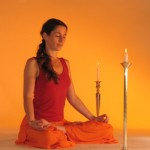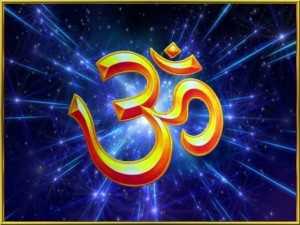 How to Meditate
How to Meditate
 Meditation practice is more than sitting cross-legged, with your eyes closed, and chanting Om. Although this is one way to begin the process of meditation, there’s a whole lot more about the practice of meditation.
Meditation practice is more than sitting cross-legged, with your eyes closed, and chanting Om. Although this is one way to begin the process of meditation, there’s a whole lot more about the practice of meditation.
Meditation, or Dhyana is the seventh limb of Patanjali’s Eight Limbs of Yoga. According to Patanjali, dhyana is
“…the continuous flow of cognition towards that object.”
To learn to meditate means to focus the mind with concentration on one fixed idea, object, sound or thought.
* Free Audio mp3 – Guidance and About Meditation – by ~Gurudevi
Hong Sau Technique:
Close your eyes for a moment and get into a comfortable position.
Take several deep breaths and then breathe naturally.
Concentrate on your breathing – slowing it down as you relax.
Now as you inhale, think the word Hong (rhymes with long). As you exhale, think the word Sau (rhymes with saw). Clear your mind of all other thoughts except for Hong on the inhale and Sau on the exhale. Continue the Hong Sau practice for 10 to 15 minutes.
Open your eyes. Take a few deep breaths before getting up.
Meditation practice is beneficial because the mind calms down and enters into a peaceful experience. The inner soul consciousness feels bathed in joy and bliss. Your thoughts and emotions effect the whole body.
All actions begin with a thought – whether consciously or unconsciously – the truth is that all action begins in the mind.
By practicing meditation every day, you will begin to build neurological pathways in your brain. Control of your thoughts, mind and emotions will become easier. Ultimately, inner peace, health and wisdom result.
Meditation Practice
 Meditation can be done anywhere and in any position: from lying down in bed or washing the dishes, to sitting in a chair or taking a walk. Meditation helps you to connect your spirit with the One Spirit; the Creator.
Meditation can be done anywhere and in any position: from lying down in bed or washing the dishes, to sitting in a chair or taking a walk. Meditation helps you to connect your spirit with the One Spirit; the Creator.
The Hindu scriptures describe meditation as
“…pouring oil from one pot to another.”
Put a different way, meditation is taking concentration from one item and placing it towards another.
If you tried the exercise above, you’ll come to realize just how difficult this can be. Above all, do not despair. Frustration will only lead you further away from attaining your goal. Instead, be gentle with yourself as you meditate. If your mind wanders, simply bring it back to your inner focus.
Simply noticing that your mind has wandered will give you the awareness you need to bring it back to the focus of your concentration. By shining the light of awareness on your wandering thoughts, you will gently bring yourself back to meditation.
Meditation is a life-long practice. Each meditation practice is a unique experience with different emotions, feelings and thoughts. Let that happen. Meditation is as much about control as it is about letting go. Deep meditation is a blissful state of mind beyond the intellect or ego. The little self discovers it’s inner true greater Self.
To get started with meditation, Patanjali suggests using an object, place or idea to concentrate on.
This first stage of meditation, also the sixth limb of yoga, is called dharana. According to the Yoga Sutras, Dharana is,
“…the binding of the mind to one place, object or idea.”
First, get into a comfortable position. You do not need to sit cross-legged, unless this is comfortable for you. You may lie down, however be careful not to fall asleep. If you find yourself drifting off into sleep, take a nap before you meditate. If you are getting enough sleep, lying down should not cause you to fall asleep.
However, if you are still having problems falling asleep, you may want to try sitting up to meditate. If a cross-legged position is uncomfortable, try sitting on a stiff chair.
Once you are in position, close your eyes and breath deeply a few times.
Now it’s time to point your mind towards one thing, and one thing only. You have three different objects of concentration to choose from. I suggest trying all three to see which one works best for you.
The Breath
When meditating on the breath, simply pay close attention to each inhalation and each exhalation. Don’t force the breath to be slow or fast, just breathe naturally and concentrate. Concentrate on the breath coming in and out; as if you are the breath coming in and out of your body.
Feel the air as it moves into your throat, your chest, your belly. Notice when you’ve come to the end of your inhale, there is a slight pause before the exhalation begins. Feel that feeling of being full of air.
Now notice as the air leaves your lungs. First your solar plexus release, then your chest contracts, you feel the air coming through your throat and finally out of your nose. Feel the feeling of peace and relax.
An Image
In practicing meditation try using a mental image to meditate on. You may pick whatever image works for you. However, here are a few suggestions:
- A rose, a tree, the moon, the ocean
- Your Guru, or a picture of You
- Divine Hindu Goddess, Dakini, Yogini
- Jesus, Buddha, Krishna, Brahma, Vishnu, Shiva
Once you have that image in your mind, close your eyes and hold it there. Imagine as if it were right in front of you. Concentrate only on that image. Let yourself feel all feelings you may have associated with that image.
A Mantra
The third variation of mediation involves a mantra. A mantra is simply a word, phrase or sound which is held in the mind. This practice is called Japa. It can either be related to the movement of breath, or simply a constant repetitive sound or phrase.
- Hong (rhymes with song) on the inhale, and Sau (rhymes with saw) on the exhale.
- Om Om Om Om
- Your favorite prayer
- Your own name
- Om Mani Padme Hum
Your concentration will be only on these sounds or phrase. As soon as the mind wanders to other things, gently place your awareness on the wandering thought and bring your mind back to your mantra.
Once you have gone deeper into meditation, you will begin to feel deeper emotions surface which connect you to the Divine.
Daily practice of meditation is beneficial, even if for five minutes per day. You will make mental and emotional breakthroughs you never thought possible. You you experience blessings unfolding in your life and uplifting others around you.
Meditation Mantra
Leads you through mantras in and out of meditation:
3 times Om; invocation mantras;
Silence for meditation session – (timed like an alarm clock),
3 times Om; Purnamadah; Om Shanti
– 10 minutes silent meditation – Audio MP3
LEVEL ONE – Raising Vitality, Strength and Awareness
Complied with love by Dave West
Himalaya Yoga aims is to provide authentic Himalayan wisdom and yoga training
For your health and happiness, and for the spiritual evolution of mankind
From the section on Mantra:
The chanting of mantras activates and accelerates the creative spiritual force, promoting harmony in all parts of the human being. The devotee is gradually converted into a living centre of spiritual vibration, which may be directed for the benefit of the one who uses it and for that of others.
During the early stages of Yogic practice, the chosen mantra has to be repeated over and over again with effort of will and full awareness. This awareness and concentration prevents the mind from thinking of other things. Eventually after continuous and dedicated practice, the mantra is repeated automatically without strain or effort. The mantra spontaneously manifests itself and becomes an integral part of the mind. The mind vibrates with the sound of the mantra. It becomes an integral part of the individual’s being and needs absolutely no conscious effort. It repeats itself spontaneously with every breath, day and night. This is a very powerful way of approaching meditation states, for the mind is rendered calm and concentrated.The mantra acts as a pathway between normal states of consciousness and super consciousness.


